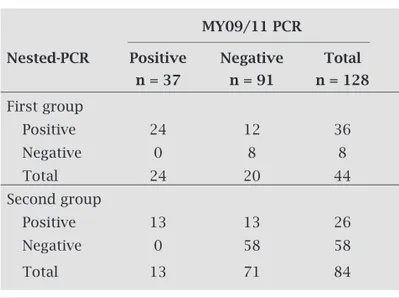Human papillomavirus detection and typing using a nested-PCR-RFLP assay
Texto
Imagem

Documentos relacionados
Niessen and Vogel (42) developed a PCR-based assay to detect Fusarium species potentially producing trichothecenes using a pair of primers derived from the DNA sequence of
In order to detect several new HLA-A class I alleles that have been described since 1998, the original PCR-RFLP method developed to identify the 78 alleles recognized at that time
This study describes the applica- tion of a reverse transcription-polymerase chain reaction (RT-PCR) assay using random primers (PdN6) and specific Ni and E3 primers, directed at
The sensitivity of the qPCR assay development in this study was tested against a standard qPCR method- ology and the Ct values of the p3G primers were com- pared with
Plasmodium falciparum genomic DNA (2 ng) was detected by nested PCR using Plasmodium species detection primers in the presence of various concentrations of dried blood obtained
caninum in aborted bovine fetuses using IHC and nested-PCR (primers of the ITS1 region of the parasite and the Nc5 sequence), as well as on the basis of histopathological lesions
occidentalis based on low stringency polymerase chain reaction and using a pair of primers specific for the amplification of the 18S rRNA gene.. Analysis of the low stringency
Desse modo, o artigo apresenta um estudo sobre a deficiência visual, em espe- cífico a baixa visão em relação à iluminação artificial de ambientes internos, e busca.. apresentar